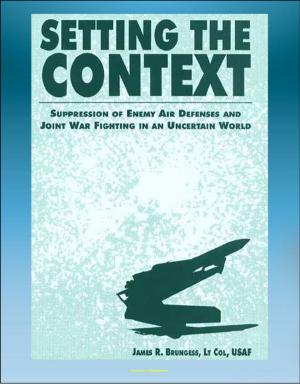Shuttle-Mir: The United States and Russia Share History's Highest Stage (NASA SP-2001-4225) - Forerunner to International Space Station (ISS) Operations, Human Side of Successes and Accidents on Mir
Nonfiction, Science & Nature, Science, Physics, Astronomy, History, Americas| Author: | Progressive Management | ISBN: | 9781465721778 |
| Publisher: | Progressive Management | Publication: | November 18, 2011 |
| Imprint: | Smashwords Edition | Language: | English |
| Author: | Progressive Management |
| ISBN: | 9781465721778 |
| Publisher: | Progressive Management |
| Publication: | November 18, 2011 |
| Imprint: | Smashwords Edition |
| Language: | English |
This remarkable NASA history publication provides a gripping account of the Shuttle-Mir program from 1994 through 1998. This volume was converted for accurate flowing-text e-book format reproduction by World Spaceflight News.
It presents the human side of the Shuttle-Mir story, beginning by setting the historical stage. It then alternates between efforts of the team members on the ground, the missions of the American Space Shuttles to and near Mir, and the tales of the seven American astronauts who, with their Russian crewmates, endured months in Earth orbit. It is based on reflections and quotes from the astronauts, cosmonauts, and team members who participated in the historic partnership. American astronauts faced drama, drudgery and - at times - grave danger. Meanwhile on Earth, American and Russian teams worked through distrust toward reliance. Beating their Cold War swords into high-tech plowshares, they forged a technical and operational achievement out of a half-century of hostile competition. And between Earth and Mir, America's Space Shuttles delivered, again and again, carrying people and cargo to the orbital outpost. Shuttle-Mir is the story of the world's first two spacefaring peoples, and of how they cast off the past to ernbrace the future.
Contents include: STS-60 - Russian Cosmonaut Sergei Krikalev helped begin the Shuttle-Mir experience with his flight aboard Discovery. STS-63 - During the "near Mir" mission, Discovery approached within 35 feet of the Russian space station. NASA-1 Norm Thagard - The former Cold War jet pilot embodied the peaceful close of a belligerent century as he launched into space with his two Russian crewmates. Cooperation in space entered a new era. STS-71 - Atlantis made the first Shuttle-Mir docking and transported a crew of cosmonauts to begin their expedition on the Russian space station. STS-74 - Atlantis delivered a Russian-built module for future Orbiter dockings along with water, supplies, and equipment to Mir. Training and Operations - Getting its astronauts ready for Mir and running a long-duration program required NASA to accommodate differences in cultures, languages, practices, and time zones. STS-76 - Atlantis delivered Shannon Lucid to Mir, and U.S. Astronauts Godwin and Clifford conducted the first spacewalk around the two mated spacecraft. NASA-2 - She returned from space a hero and a teacher of patience, but Lucid went up to Mir more as a student. STS-79 - Atlantis brought John Blaha to the station for the first American crew exchange. NASA-3 John Blaha - As the first astronaut to directly follow a previous U.S. Mir resident, Blaha went to work improving the "handover" process. STS-81 - The crew aboard Atlantis retrieved the wheat planted by Lucid and Blaha while delivering Jerry Linenger for his residency. NASA-4 Jerry Linenger flew to Mir to do world-class science, but scarcely had he begun when fate stepped in. An accidental fire changed the nature of his mission and the relationship between NASA and the Russian Space Program. STS-84 - Atlantis brought Mike Foale to replace Linenger. NASA-5 Mike Foale - Launching through controversy, Foale settled in on Mir. Then, a collision, depressurization, and the loss of station control tested his skills and endangered the program. STS-86 - Atlantis crewmembers Parazynski and Titov conducted the first joint U.S.-Russian spacewalk during the Shuttle mission that replaced Foale with David Wolf. STS-89: Last NASA Astronaut to Mir - Endeavour, the first Orbiter after Atlantis to dock with Mir, arrived with Andy Thomas and delivered more than 8,000 pounds of equipment and supplies, then departed with Wolf. NASA-7 Andy Thomas - The anchor leg of NASA's Mir relay was the smoothest of the seven, although it had its share of difficulties and frustration. STS-91: Closing Out Shuttle-Mir.
This remarkable NASA history publication provides a gripping account of the Shuttle-Mir program from 1994 through 1998. This volume was converted for accurate flowing-text e-book format reproduction by World Spaceflight News.
It presents the human side of the Shuttle-Mir story, beginning by setting the historical stage. It then alternates between efforts of the team members on the ground, the missions of the American Space Shuttles to and near Mir, and the tales of the seven American astronauts who, with their Russian crewmates, endured months in Earth orbit. It is based on reflections and quotes from the astronauts, cosmonauts, and team members who participated in the historic partnership. American astronauts faced drama, drudgery and - at times - grave danger. Meanwhile on Earth, American and Russian teams worked through distrust toward reliance. Beating their Cold War swords into high-tech plowshares, they forged a technical and operational achievement out of a half-century of hostile competition. And between Earth and Mir, America's Space Shuttles delivered, again and again, carrying people and cargo to the orbital outpost. Shuttle-Mir is the story of the world's first two spacefaring peoples, and of how they cast off the past to ernbrace the future.
Contents include: STS-60 - Russian Cosmonaut Sergei Krikalev helped begin the Shuttle-Mir experience with his flight aboard Discovery. STS-63 - During the "near Mir" mission, Discovery approached within 35 feet of the Russian space station. NASA-1 Norm Thagard - The former Cold War jet pilot embodied the peaceful close of a belligerent century as he launched into space with his two Russian crewmates. Cooperation in space entered a new era. STS-71 - Atlantis made the first Shuttle-Mir docking and transported a crew of cosmonauts to begin their expedition on the Russian space station. STS-74 - Atlantis delivered a Russian-built module for future Orbiter dockings along with water, supplies, and equipment to Mir. Training and Operations - Getting its astronauts ready for Mir and running a long-duration program required NASA to accommodate differences in cultures, languages, practices, and time zones. STS-76 - Atlantis delivered Shannon Lucid to Mir, and U.S. Astronauts Godwin and Clifford conducted the first spacewalk around the two mated spacecraft. NASA-2 - She returned from space a hero and a teacher of patience, but Lucid went up to Mir more as a student. STS-79 - Atlantis brought John Blaha to the station for the first American crew exchange. NASA-3 John Blaha - As the first astronaut to directly follow a previous U.S. Mir resident, Blaha went to work improving the "handover" process. STS-81 - The crew aboard Atlantis retrieved the wheat planted by Lucid and Blaha while delivering Jerry Linenger for his residency. NASA-4 Jerry Linenger flew to Mir to do world-class science, but scarcely had he begun when fate stepped in. An accidental fire changed the nature of his mission and the relationship between NASA and the Russian Space Program. STS-84 - Atlantis brought Mike Foale to replace Linenger. NASA-5 Mike Foale - Launching through controversy, Foale settled in on Mir. Then, a collision, depressurization, and the loss of station control tested his skills and endangered the program. STS-86 - Atlantis crewmembers Parazynski and Titov conducted the first joint U.S.-Russian spacewalk during the Shuttle mission that replaced Foale with David Wolf. STS-89: Last NASA Astronaut to Mir - Endeavour, the first Orbiter after Atlantis to dock with Mir, arrived with Andy Thomas and delivered more than 8,000 pounds of equipment and supplies, then departed with Wolf. NASA-7 Andy Thomas - The anchor leg of NASA's Mir relay was the smoothest of the seven, although it had its share of difficulties and frustration. STS-91: Closing Out Shuttle-Mir.















